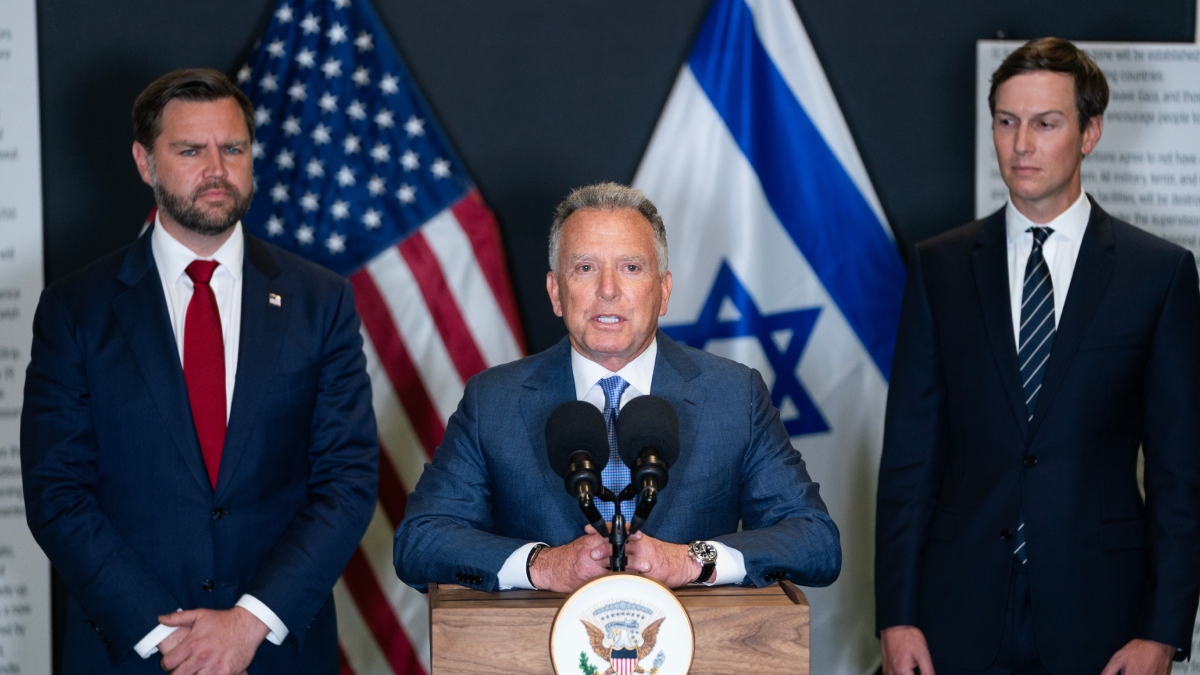Gaza ceasefire 'going better than expected', says US Vice President JD Vance during Israel visit
 U.S. Vice President JD Vance, U.S. Special Envoy to the Middle East Steve Witkoff, and Jared Kushner attend a news conference following a military briefing at the Civilian Military Coordination Center in southern Israel | AP
U.S. Vice President JD Vance, U.S. Special Envoy to the Middle East Steve Witkoff, and Jared Kushner attend a news conference following a military briefing at the Civilian Military Coordination Center in southern Israel | AP
US Vice President JD Vance expressed cautious optimism about the Gaza ceasefire during his ongoing visit to Israel, declaring the truce is “going better than expected” and likely to hold, despite recent flare-ups. Speaking at a news conference in southern Israel, Vance said, “What we’ve seen the past week gives me great optimism the ceasefire is going to hold,” while conceding he could not offer “100 per cent certainty” of its durability.
Vance refrained from setting a timeline for two of the most contentious clauses of the agreement brokered by President Donald Trump—the disarmament of Hamas and the return of Israeli hostages’ remains. He acknowledged the complexity of the process, stressing that the implementation of humanitarian and security structures in Gaza would take time. Calling Hamas a “terrorist organisation,” he said Israel’s military actions throughout the conflict had been defensive.
The Vance visit comes amid growing concerns about the truce’s fragility following a weekend incident in which two Israeli soldiers were killed in an alleged Hamas attack. Dozens of Palestinians were subsequently killed in Israeli retaliatory strikes. Although both Israel and Hamas accused one another of violating the terms of the truce, they ultimately reaffirmed their commitment to the Trump Plan.
Behind the scenes, US officials scrambled to prevent the collapse of the 12-day-old truce, viewing Vance’s visit as a strategic signal to Israeli leadership. One US official described the effort as “Bibisitting”, intended to underscore the administration’s resolve in maintaining the deal.
A significant obstacle remains the disarmament of Hamas—a non-negotiable demand from Israel, but one the group equates with surrender. Disarmament has long been at odds with Hamas’s ideology of armed resistance. Vance avoided issuing ultimatums, saying it would not be “advisable” to insist on a fixed timeline for this demand.
Joining Vance at the facility were Jared Kushner, Trump’s son-in-law and one of the key negotiators, and Steve Witkoff, the Trump administration’s Middle East envoy. Both played key roles in brokering the ceasefire, along with mediators from Egypt, Qatar and Turkey. Witkoff urged the Israeli government to respond proportionately to future violations and emphasised that the next 30 days would be crucial for transitioning to a second phase of negotiations.
Hamas, meanwhile, reaffirmed its commitment to the ceasefire during a meeting with Turkish officials. The group blamed Israel for recent violations but pledged to uphold the agreement, including efforts to return the remains of approximately 15 Israeli hostages. Senior Hamas figure Khalil al-Hayya acknowledged the difficulty in retrieving the bodies, citing the devastation and shifting landscape in Gaza after two years of war.
As part of broader stabilisation efforts tied to the Trump Peace Plan, the US unveiled a Civil-Military Coordination Centre (CMCC) in southern Israel. The centre, intended to coordinate humanitarian and logistical support to Gaza, will host representatives from partner nations, NGOs and international bodies. While US forces will not operate inside Gaza, the CMCC will monitor ceasefire compliance through a real-time operations floor, according to a statement from US Central Command. Already, 200 American troops have reached Israel to work at the CMCC.
Amid these developments, Prime Minister Benjamin Netanyahu dismissed his national security adviser, Tzachi Hanegbi, without providing an official reason. Israeli media speculated the move was linked to Hanegbi’s opposition to resuming military operations in Gaza earlier this year and Israel’s failed attempt to assassinate Hamas leadership in Qatar. In a farewell statement, Hanegbi admitted “disagreements” with Netanyahu and called for a full investigation into the security lapses that enabled Hamas’s October 7, 2023, assault on Israel. “The terrible failure … must be thoroughly investigated to ensure that the appropriate lessons are learned and to help restore the trust that has been shattered,” Hanegbi wrote.
Netanyahu is expected to meet Vance today, though he offered few specifics about the agenda. Addressing the Knesset on October 20, the Israeli prime minister said only that their discussion would focus on “security challenges and diplomatic opportunities.” Stepping up diplomatic efforts, Netanyahu yesterday met with Egypt’s intelligence chief, General Hassan Rashad, to review ceasefire arrangements and other regional concerns.
Shortly after Vance’s arrival in Israel, Trump issued a warning that should Hamas violate the agreement, several unnamed US allies in the region stood ready to respond with “heavy force.” “The love and spirit for the Middle East has not been seen like this in a thousand years! It is a beautiful thing to behold! I told these countries, and Israel, ‘NOT YET!, Trump wrote yesterday on his social media platform Truth Social. “There is still hope that Hamas will do what is right. If they do not, an end to Hamas will be FAST, FURIOUS, & BRUTAL!”
Middle East